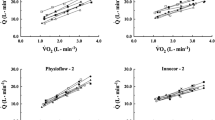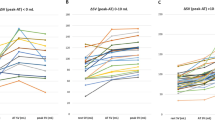Abstract
This study evaluated impedance cardiography (ZCG) estimates of stroke volume (SV) during exercise. Seven subjects were studied at rest and during progressive cycle exercise in supine and upright positions. SV was determined by ZCG (SVzcg) during exercise and for the first 5 cardiac cycles following exercise. SVzcg was compared with separate measurements of SV by CO2 rebreathing (SVco 2). Static blood resistivity (ρ) was measured at each level of exercise. No significant differences were found between supine exercise and immediate post-exercise values for the peak of the first derivative of the impedance change (dZ/dt max), left ventricular ejection time (LVET), or SVzcg. Small differences indZ/dt max and SVzcg, but not LVET, were found in exercise to post-exercise cycling in the upright position. Intra-individual SVzcg and SVco 2 were moderately correlated (upright meanr=0.64, supiner=0.42) from rest to 70% of peak\(\dot Vo_2 \). Similar correlations were found between Pulse-O2 (\(\dot Vo_2 \)/heart rate, used as an index to SV) and both SVzcg (uprightr=0.73, supiner=0.57) and SVco 2 (uprightr=0.8, supiner=0.65). The ZCG parametersdZ/dt max and LVET correlated better with Pulse-O2 (dZ/dt max: uprightr=0.92, supiner=0.73; LVET: uprightr=−0.9, supiner=−0.9). SVzcg calculated with the Kubicek equation performed as well as SVco 2. ZCG might be a superior method if the inversely correlated parameters,dZ/dt max and LVET, were not expressed as a product to calculate SV.
Similar content being viewed by others
References
Altman, D. G. Practical Statistics for Medical Research, London: Chapman and Hall, 1991.
Bland, J. M., and D. G. Altman. Statistical methods for assessing agreement between two methods of clinical measurement.Lancet 307–310, 1986.
Collier, C. Determination of mixed venous CO2 tension by rebreathing.J. Appl. Physiol. 9:25–29, 1956.
Coyle, E. F., M. K. Hemmert, and A. R. Coggan. Effects of detraining on cardiovascular responses to exercise: role of blood volume.J. Appl. Physiol. 60:95–99, 1986.
Defares, J. G. Determination of Pv co 2 from exponential CO2 rise during rebreathing.J. Appl. Physiol. 13:159–164, 1958.
Denniston, J. C., J. T. Maher, J. T. Reeves, J. C. Cruz, A. Cymerman, and R. F. Grover. Measurement of cardiac output by electrical impedance at rest and during exercise.J. Appl. Physiol. 40:91–95, 1976.
Doerr, B. M., D. S. Miles, and M. A. B. Frey. Influence of respiration on stroke volume determined by impedance cardiography.Aviat. Space Environ. Med. 52:394–398, 1981.
Du Quesnay, M. C., G. J. Stoute, and R. L. Hughson. Cardiac output in exercise by impedance cardiography during breath hold and normal breathing.J. Appl. Physiol. 62:101–107, 1987.
Edmunds, A. T., S. Godfrey, and M. Tooley. Cardiac output measured by transthoracic impedance cardiography at rest, during exercise and at various lung volumes.Clin. Sci. 63:107–113, 1982.
Fujinami, T., S. Nakano, K. Nakayama, and K. Takada. Impedance cardiography for the assessment of cardiac function during exercise.Jpn. Circ. J. 43:215–233, 1979.
Geddes, L. A., and C. Sadler. The specific resistance of blood at body temperature.Med. Biol. Eng. 11:336–339, 1973.
Hill, D. W., and F. D. Thompson. The effect of haematocrit on the resistivity of human blood at 37°C and 100 kHz.Med. Biol. Eng. 13:182–186, 1975.
Kobayashi, Y., Y. Andoh, T. Fujinami, K. Nakayama, K. Takada, T. Takeuchi, and M. Okamoto. Impedance cardiography for estimating cardiac output during submaximal and maximal work.J. Appl. Physiol. 45:459–462, 1978.
Kubicek, W. G., J. N. Karnegis, R. P. Patterson, D. A. Witsoe, and R. H. Mattson. Development and evaluation of an impedance cardiac output system.Aerospace Med. 37: 1208–1212, 1966.
Miles, D. S., M. N. Sawka, S. W. Wilde, B. M. Doerr, M. A. B. Frey, and R. M. Glasser. Estimation of cardiac output by electrical impedance during arm exercise in women.J. Appl. Physiol. 51:1488–1492, 1981.
Miles, D. S., M. N. Sawka, D. H. Hanpeter, J. E. Foster, B. M. Doerr, and M. A. B. Frey. Central hemodynamics during progressive upper- and lower-body exercise and recovery.J. Appl. Physiol. 57:366–370, 1984.
Milsom, I., R. Sivertsson, B. Biber, and T. Olsson. Measurement of stroke volume with impedance cardiography.Clin. Physiol. 2:409–417, 1982.
Miyamoto, Y., J. Higuchi, Y. Abe, T. Hiura, Y. Nakazono, and T. Mikami. Dynamics of cardiac output and systolic time intervals in supine and upright exercise.J. Appl. Physiol. 55:1674–1681, 1983.
Miyamoto, Y., T. Hiura, T. Tamura, T. Nakamura, J. Higuchi, and T. Mikami. Dynamics of cardiac, respiratory, and metabolic function in men in response to step work load.J. Appl. Physiol. 52:1198–1208, 1982.
Mohapatra, S. N., K. L. Costeloe, and D. W. Hill. Blood resistivity and its implications for the calculation of cardiac output by the electrical impedance technique.Intensive Care Med. 3:63–67, 1977.
Niizeki, K., Y. Miyamoto, and K. Doi. A comparison between cardiac output determined by impedance cardiography, and the rebreathing method during exercise in man.Jpn. J. Physiol. 39:441–446, 1989.
Penney, B. C. Theory and cardiac applications of electrical impedance measurements.CRC Crit. Rev. Biomed. Eng. 13:227–281, 1986.
Quail A. W., F. M. Traugott, W. L. Porges, and S. W. White. Thoracic resistivity for stroke volume calculation in impedance cardiography.J. Appl. Physiol. 50:191–195, 1981.
Quail, A. W., and F. M. Traugott. Effects of changing hematocrit, ventricular rate and myocardial inotropy on the accuracy of impedance cardiography.Clin. Exp. Pharmacol. Physiol. 8:335–343, 1981.
Tanaka, K., H. Kanai, K. Nakayama, and N. Ono. The impedance of blood: the effects of red cell orientation and its application.Jpn. J. Med. Eng. 8:436, 1970.
Traugott F. M., A. W. Quail, and S. W. White. Evaluation of blood resistivityin vivo for impedance cardiography in man, dog and rabbit.Med. Biol. Eng. Comput. 19:547–552, 1981.
Vanfraechem, J. H. I. Stroke volume and systolic time interval adjustments during bicycle exercise.J. Appl. Physiol. 46:588–592, 1979.
White, S. W., A. W. Quail, P. W. De Leeuw, F. M. Traugott, W. J. Brown, W. L. Porges, and D. B. Cottee. Impedance cardiography for cardiac output measurement: an evaluation of accuracy and limitations.Eur. Heart J. 11, (suppl 1):79–92, 1990.
Wilson, M. F., B. H. Sung, G. A. Pincomb, and W. R. Lovallo. Simultaneous measurement of stroke volume by impedance cardiography and nuclear ventrilography: comparisons at rest and exercise.Ann. Biomed. Eng. 17:475–482, 1989.
Zvyagintsev, V. V. Measurement of blood resistivity.Meditsinskaya Tekhnika (trans.) 5:30–32, 1982.
Author information
Authors and Affiliations
Rights and permissions
About this article
Cite this article
Moon, J.K., Coggan, A.R., Hopper, M.K. et al. Stroke volume measurement during supine and upright cycle exercise by impedance cardiography. Ann Biomed Eng 22, 514–523 (1994). https://doi.org/10.1007/BF02367087
Received:
Revised:
Accepted:
Issue Date:
DOI: https://doi.org/10.1007/BF02367087




